The Calathea Warscewiczii produces large, velvety green foliage adorned with a striped pattern – in fact, its this velvet texture on its leaves that gives this plant its other name: the Jungle Velvet Calathea.
The underside of these leaves have a contrasting deep maroon color, making it a stunning plant that can add interest and a touch of the tropics to just about any room in your home.
Unfortunately, this plant is often overlooked due to its fussy nature. But how demanding is the Calathea Warscewiczii?
Let’s take a look at what is all required to successfully grow this rare Calathea cultivar.
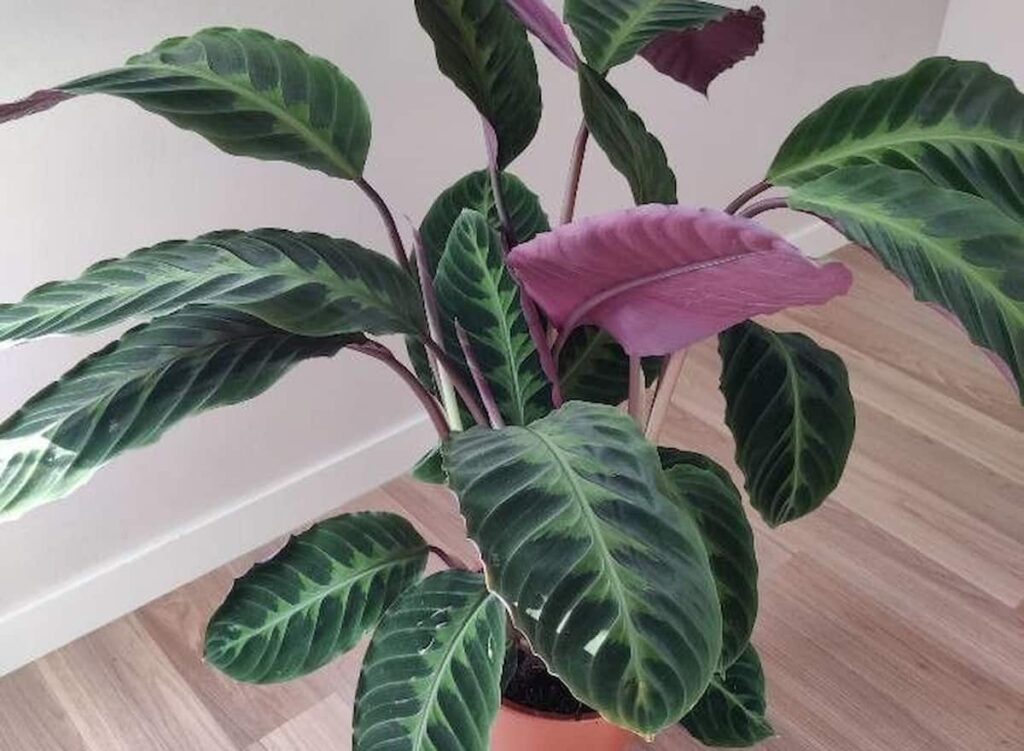
Table of Contents
How do you care for calathea warscewiczii?
Calathea Warscewiczii is a tropical plant that needs high humidity levels, warm temperatures throughout the entire year, soil that is moist but not soggy, and bright, indirect sunlight. You should also fertilize it monthly during its active growing season.
These requirements are typical for plants native to tropical regions, but some gardeners, especially those who have not grown tropical plants in the past, may find them a bit overwhelming.
Just because the Calathea Warscewiczii may require a bit more care than you’re used to doesn’t mean you shouldn’t try your hand at growing this plant!
In fact, it can be quite rewarding to successfully grow any Calathea variety. It can also help make you more comfortable with plants that need extra attention.
How much light does calathea warscewiczii need?
The leaves of the Calathea Warscewiczii can quickly scorch when exposed to direct sunlight. Because of this, the Calathea Warscewiczii needs medium to bright light, which is indirect. A west-facing window is ideal for this plant, but it can also be placed near a north- or east-facing window.
No matter which window you place the plant near, make sure it is equipped with a sheer curtain or blind to help diffuse any harsh sunlight that may shine through.
Allowing direct sun to shine on the Calathea will scorch and burn the plant’s foliage and can even interfere with its growth rate.
Related: Calathea Light Requirements: The Ultimate Guide
How often should I water a calathea warscewiczii?
You should wait until the top inch of soil starts to feel dry before watering Calathea Warscewiczii. This plant likes its soil to stay moist without being soggy and is also sensitive to overwatering, so finding the balance between the two is important.
By waiting until the soil has dried out a bit, this will ensure that the Calathea Warscewiczii gets the hydration it needs without the threat of water-logged roots.
Expect to water the Calathea Warscewiczii about once every 7 to 10 days. However, the exact timeframe will depend on the size of the plant, time of year, and environmental conditions. The hotter and drier it is, the more you will need to water the calathea plant.
Additionally, the Calathea Warscewiczii will require less watering during the fall and winter months when the plant isn’t actively growing than it will during the spring and summer.
Do you water calathea warscewiczii from top or bottom?
The bottom-watering technique is a great way to water your Calathea Warscewiczii. Using this watering method, you reduce the chance of drowning the Calathea in their pots. Instead, the soil absorbs only the moisture that it is able to hold.
This helps prevent overwatering, diseases, and even pests. It does, however, require a little more time than traditional watering, since bottom-watering can take up to 40 minutes and you will need to check the soil moisture level every 10 minutes.
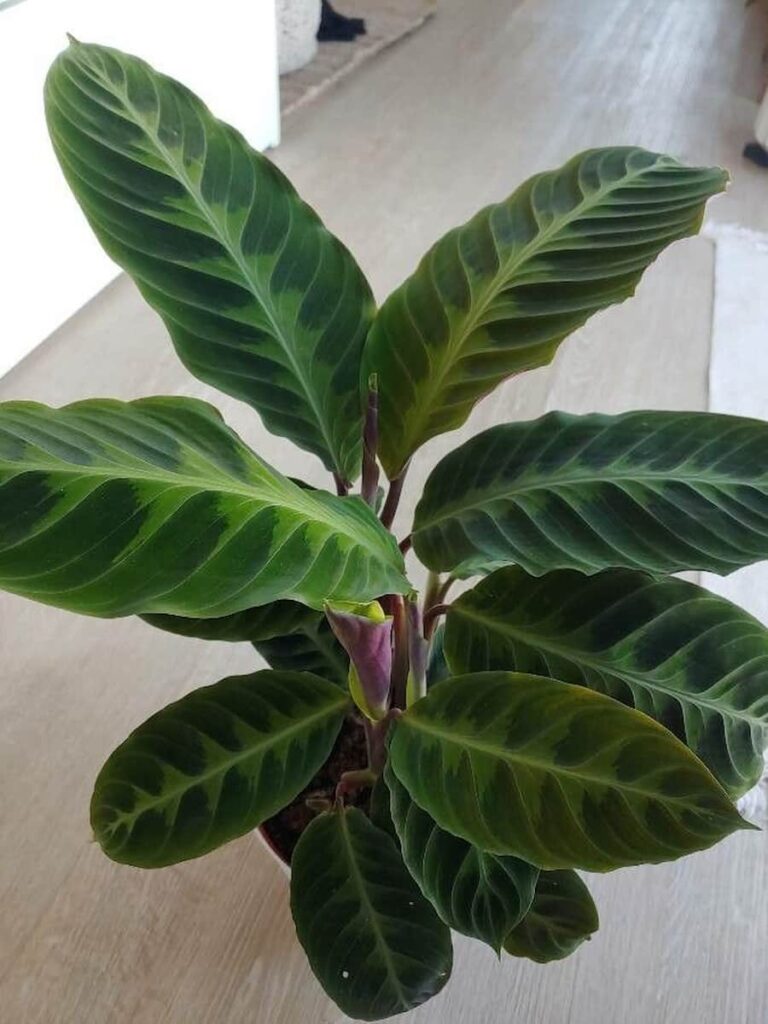
What does an overwatered calathea warscewiczii look like?
It is easy to determine when the Calathea Warscewiczii has been overwatered, since the plant will develop distinctive symptoms. The most common of these is yellowing leaves that are droopy or wilted. These leaves may also fall off the plant.
Other signs that the Calathea Warscewiczii has been overwatered include soft leaves and stems, brown tips on the leaves, stems turning brown or black, overly soggy soil, mold or mildew growing on the top of the soil, and an unpleasant odor coming from the plant.
What’s the best soil for calathea warscewiczii?
When looking for the best soil for Calathea Warscewiczii, choose one that not only drains well, but also retains moisture. This will help prevent root rot, while also ensuring the Calathea still gets enough water to keep it healthy.
Traditional houseplant potting soil works well as long as you amend the mixture with some perlite. The perlite will help improve drainage and moisture retention.
Alternatively, create your own mixture by combining 1 part perlite with 2 parts coco coir or peat moss.
You may also be interested in: Best Calathea Soil: Tips to Pick the Right Potting Mix
What are the ideal calathea warscewiczii humidity levels?
Calathea Warscewiczii is a tropical plant that needs a humidity level of at least 60 percent, although higher than this is better. This is a higher humidity level than what most homes have and so you’ll need to increase humidity levels in the room where the Calathea Warscewiczii is growing.
The two most common ways to increase the humidity is to set the Calathea Warscewiczii on a drip tray or use a humidifier near the plant.
Both options work well to reach Calathea’s desired humidity. Another way to increase humidity is to mist the plant’s leaves, although this is only a temporary fix.
Should I mist my calathea warscewiczii?
Dry air can quickly cause the Calathea Warscewiczii to develop brown, dry, and crispy foliage. When you pair that with the fact that Calatheas love humidity, you will quickly realize just how much misting them can help improve their overall health and happiness.
This is especially true when conditions are hotter or drier than normal. It can cause the plant’s leaves to turn brown, crispy, and fall off the plant, while also slowing down its growth.
Misting the Calathea Warscewiczii’s leaves helps to prevent this from occurring.
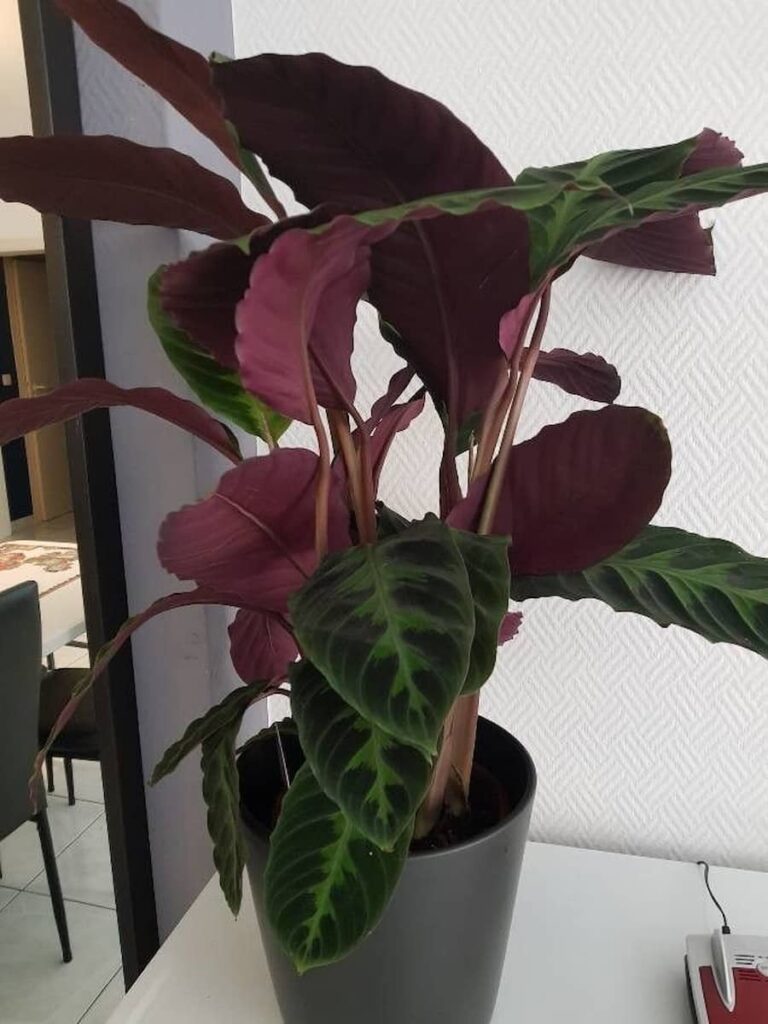
Should I fertilize calathea warscewiczii?
Even though the Calathea Warscewiczii isn’t a heavy feeder, you should still consider applying a balanced fertilizer to the plant once a month during its active growing season. Never apply fertilizer during the fall and winter as this is when the plant is in its dormant phase.
Feeding it at this time can cause damage to the plant by interfering with its growth cycle.
While fertilizing the plant is important, care should be taken not to overfertilize the Calathea Warscewiczii. Too much fertilization can burn and damage the plant, resulting in poor growth and even death.
The best way to prevent overfeeding is to follow the instructions on the back of the fertilizer bottle and never apply more than the recommended dosage.
What’s the best fertilizer for calathea warscewiczii?
The best fertilizer for Calathea Warscewiczii is a balanced, liquid fertilizer, such as 10-10-10, that is reduced to ¼ or ½ of its strength. Before applying the fertilizer, make sure to thoroughly water the Calathea Warscewiczii. Feeding the plant while its soil is dry can actually burn its roots.
Avoid fertilizers that are in a form other than liquid. These fertilizers are often called “slow release” and they can lead to overfeeding.
Additionally, these types of fertilizers usually contain more salts, which can cause a lot of damage to the Calathea Warscewiczii’s roots.
Related: Best Calathea Fertilizer for Prayer Plants (+ When to Do It)
When should you repot calathea warscewiczii?
Calathea Warscewiczii only needs to be repotted when the plant starts to become rootbound, which means its roots are running out of room. If roots are growing out of the bottom of the pot or out of the top of the soil, then you know the plant is rootbound.
If possible, try to wait to repot the Calathea Warscewiczii until it is actively growing, which is in the spring and summer.
Additionally, water the Calathea Warscewiczii thoroughly before repotting to prevent damage to the plant. If the plant is already water stressed, repotting can cause more harm and damage to the Calathea.
Making sure it is thoroughly watered beforehand helps to reduce this from occurring.
Should you prune calathea warscewiczii?
Pruning the Calathea Warscewiczii is a good way to get rid of dead, dying, and diseased leaves. Not only does this improve the overall appearance of the plant, but it helps to make room and save resources for new leaves.
However, the Calathea Warscewiczii doesn’t do well with heavy pruning, so make sure to save the pruning for leaves that are problematic and not as a way to free up space on the plant.
When you do prune, use a pair of sharp pruning shears and snip the leaves off as close to the main stem as possible. Discard the leaf in the trash.
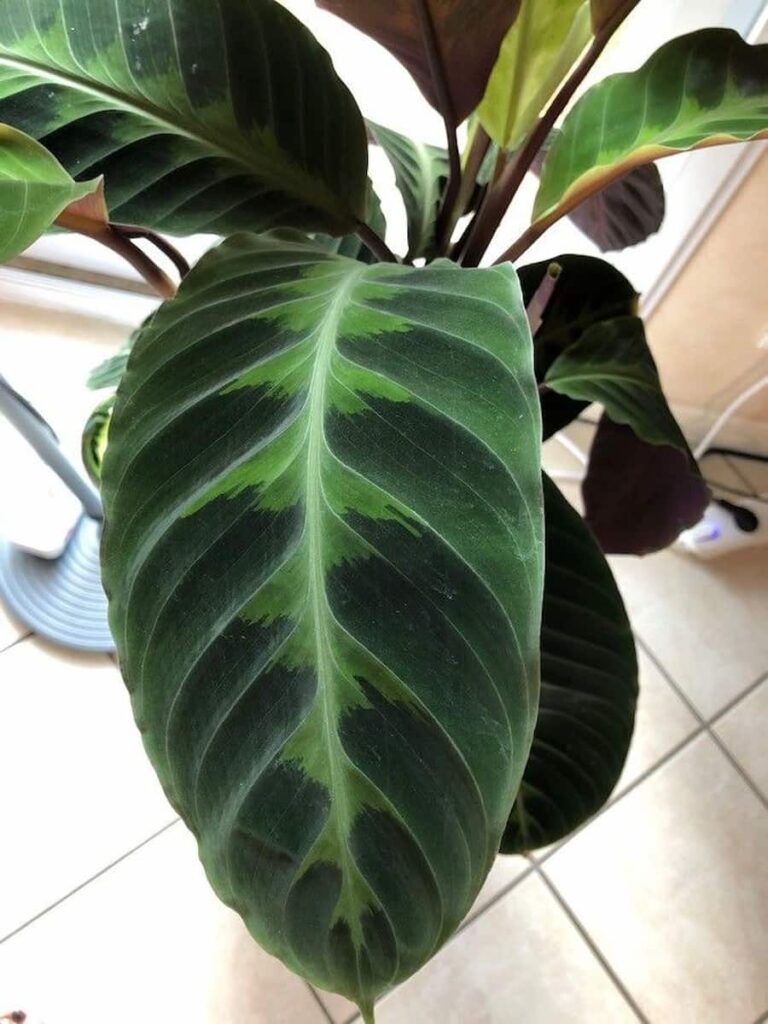
Should I cut off dying calathea warscewiczii leaves?
Cutting off dying Calathea Warscewiczii leaves is a great way to clean up the appearance of your plant, while also stopping the plant from wasting resources on the leaf. Once the leaf is removed, the Calathea Warscewiczii should redirect resources to creating new growth.
To prune, simply snip the dying leaf as close to the main stem as possible and then discard in the trash. It’s best to use either a pair of sharp pruning shears or sharp scissors. Just make sure they are properly disinfected before and after use.
Where to find a calathea warscewiczii for sale
Calathea Warscewiczii is a rare cultivar of the Calathea plant, which means it can be a bit more difficult to find. There are, however, a few online gardening stores that offer this plant for sale. Another option is to speak to your local nursery who may be able to order it.
Talking with your garden center about this can even help save you money, since you may not have to pay for shipping (unlike if you order from an online seller yourself) if the store orders the Calathea Warscewiczii when they order their other inventory.
A third option for potentially finding the Calathea Warscewiczii for sale is to seek out local gardening groups.
Sometimes, gardening groups will host plant swaps or even allow their members to sell plants. This could potentially give you the ability to get your hands on harder-to-get plants.
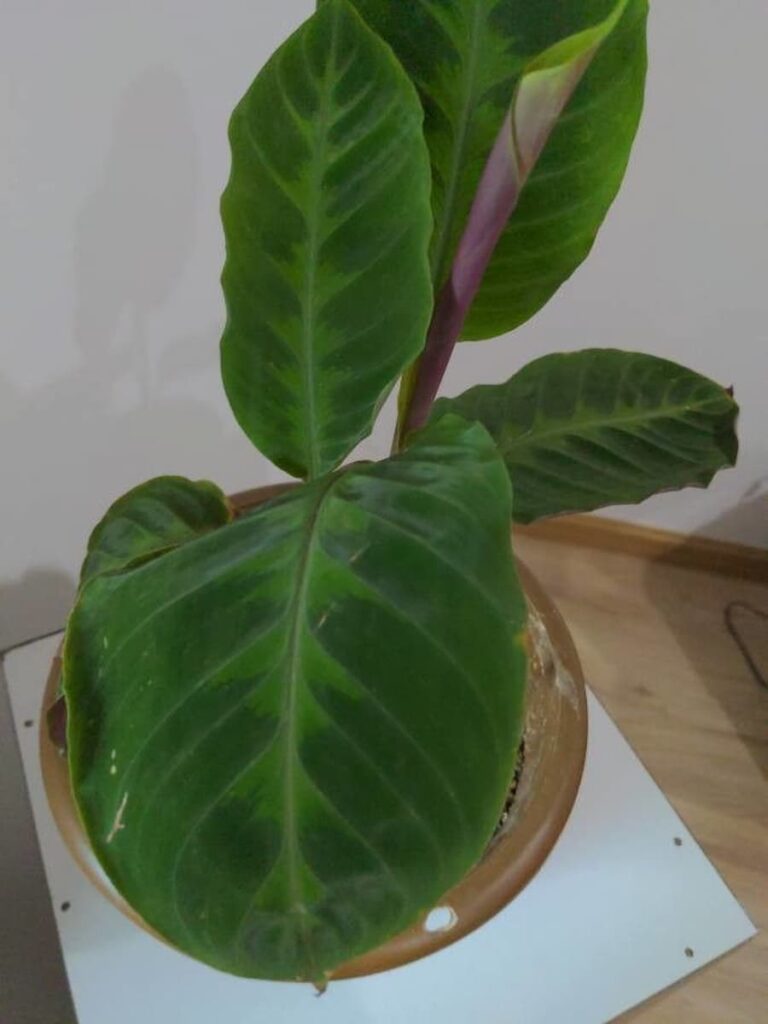
What’s a standard calathea warscewiczii price?
The standard Calathea Warscewiczii price varies on several factors, including how big and old the plant is. A smaller or younger Calathea Warscewiczii can cost $20 or under, while larger and more established plants typically carry a higher price tag.
On average, however, expect to pay close to $50 or more for a Calathea Warscewiczii in a 6-inch pot.
Calathea warscewiczii vs zebrina
Calathea Warscewiczii and Calathea Zebrina are often confused for one another due to their similar appearance. Despite this, Warscewiczii and Zebrina are two different cultivars of the same species. Calathea Zebrina has a different leaf pattern than the Calathea Warscewiczii, and it is a bit lighter in color.
They both, however, share about the same growing and care requirements, and are susceptible to the same problems and issues.
Because they share the same needs, you can grow both of these cultivars next to one another and then care for them simultaneously.

Are calathea warscewiczii hard to care for?
Calathea Warscewiczii, like other Calathea cultivars, is a bit harder to care for than some of the other popular houseplants. That doesn’t mean, however, that it is something that the average indoor gardener cannot handle.
This plant does have a very specific set of growing conditions that must be met in order to keep it healthy.
The good news is that these growing requirements are not overly difficult, but it does mean you cannot simply toss the plant in a corner of the room and forget about it.
It will require regular maintenance in order to ensure the Calathea Warscewiczii has the best chance of survival.
How to propagate calathea warscewiczii
Calathea Warscewiczii is propagated via root division, which does require removing the entire plant from its pot and then separating new shoots into its own plant. The best time to do this is during spring when you notice newly formed shoots emerging from the soil.
Once you have separated the roots of the new shoots from the mother, plant the young Calathea Warscewiczii into its own pot filled with the same soil from the parent plant.
Thoroughly water the plant and then set it in an area where it will receive bright, indirect sunlight. Mist the young plant daily until new growth emerges.
Once new growth has formed, care for the young Calathea Warscewiczii as you would an older Calathea. This means watering when the top inch of soil is dry, keeping the plant in bright, indirect light where temperatures are between 65 and 75 degrees and humidity levels are 60 percent or higher.
You may also be interested in: 10 Easy Steps to Propagate Calathea Plants
Does calathea warscewiczii flower?
The Calathea Warscewiczii does flower in its native habitat, producing tall spikes with white flowers at the tip. These flowers can last 3 to 4 weeks and often appear in late winter and early spring. Unfortunately, this plant doesn’t flower much, if at all, when grown indoors.
Even with the perfect care, the chances of the Calathea Warscewiczii flowering when grown as a houseplant is extremely low. The indoor environment doesn’t provide the plant with all that is required to produce blooms.
Why is my calathea warscewiczii drooping?
The most common reason why your Calathea Warscewiczii is drooping has to do with soil dryness. When the Calathea Warscewiczii isn’t getting proper hydration, its leaves and stems will start to droop and wilt. You may also notice the leaves turning brown and crispy.
To confirm this is the cause of the droopiness, check the soil to see if it is dry. If so, thoroughly water the Calathea Warscewiczii to help revive and hydrate the plant. The plant will typically start to show signs of improvement within a day or two.
Other potential causes of the Calathea Warscewiczii drooping are overwatering, pest infestation, diseases, poor water quality, and over fertilization. These issues are not nearly as common, however, as the plant being underwatered.
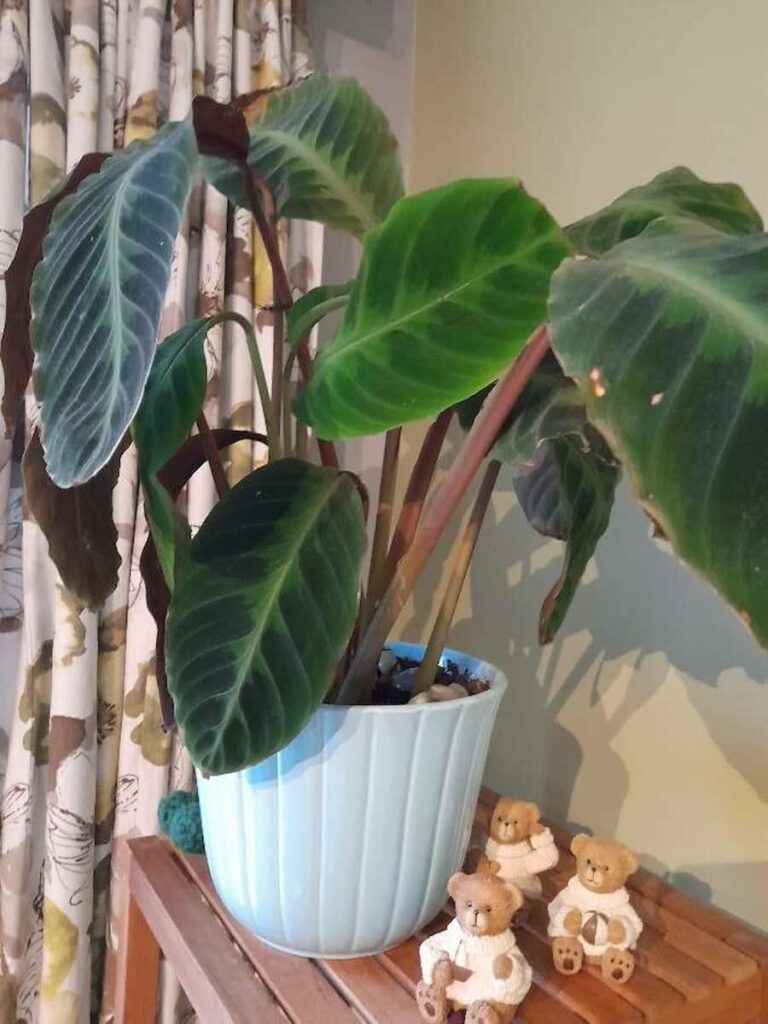
Why does my calathea warscewiczii have yellow leaves?
Yellowing leaves on the Calathea Warscewiczii are a sure sign that the plant is overwatered. While overwatering the Calathea Warscewiczii once won’t typically cause any long term damage, repeatedly overwatering can quickly lead to root rot.
Once root rot has infected the Calathea Warscewiczii, trying to save the calathea plant with yellow leaves can be extremely difficult.
If you find yourself faced with an overwatered Calathea Warscewiczii, immediately stop watering the plant and do not water again until the top inch of soil is dry. Extremely overwatered Calathea Warscewicziis will need to be removed from their pot, all the old soil discarded, and dead or diseased roots removed.
Once this has been done, repot the Calathea Warscewiczii in a clean pot with fresh soil.
Remember, an overwatered Calathea Warscewiczii will develop root rot if the moisture problem isn’t corrected. There is no cure for root rot and trying to save a plant infected with this disease is difficult. The best defense against root rot is prevention.
Why are my calathea warscewiczii leaves curling?
If you don’t give the Calathea Warscewiczii the right amount of water, the leaves will start to curl upward. This is one of the most common symptoms of an underwatered Calathea Warscewiczii. This can also occur if the air is too dry.
The good news is that the curling will typically go away once you have corrected the watering issue. If the calathea leaves curling is caused by dry conditions, increase the moisture in the air by using a drip tray or a humidifier, or mist the plant once a day.
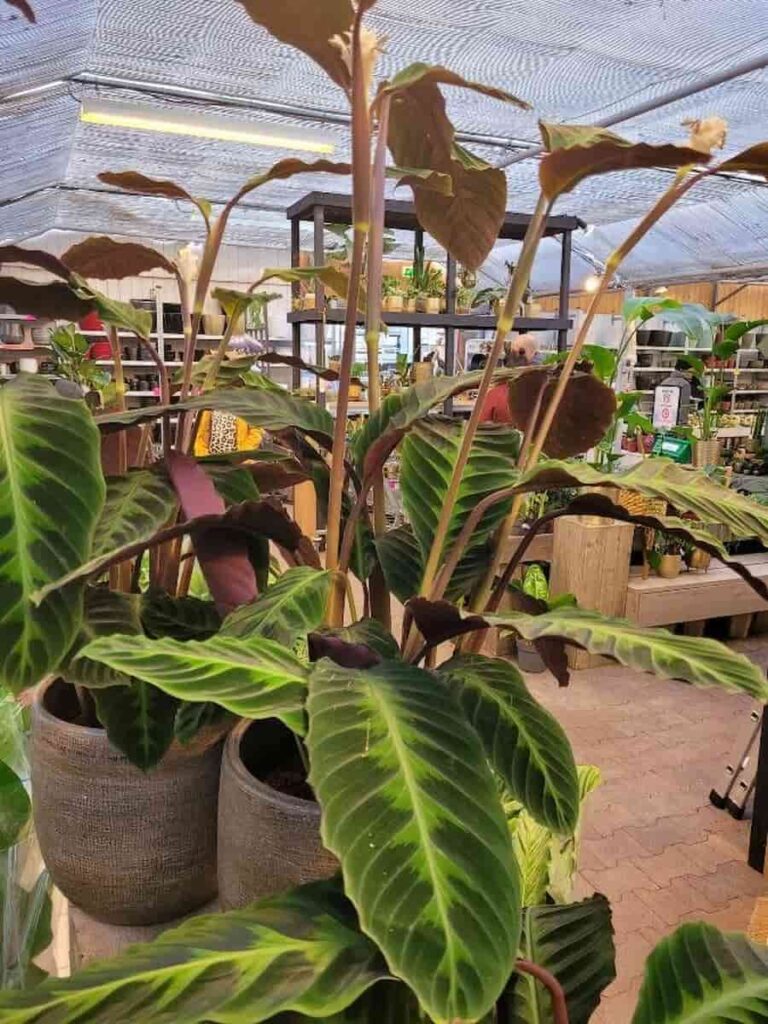
Why are my calathea warscewiczii leaves turning brown?
Brown leaves on your Calathea Warscewiczii are usually a sign that the plant isn’t getting enough moisture, or the air is way too dry for this humidity-loving plant. With that said, however, it can also be a symptom of overwatering.
To tell which one is causing the problem, simply look at the Calathea Warscewiczii’s soil.
Does the soil appear overly soggy? If so, then the brown leaves are caused by overwatering the plant. If, however, the soil is dry, then your Calathea Warscewiczii isn’t getting enough moisture.
Issues caused by too little water will require soaking the plant’s pot in water for 20 to 40 minutes, or until the soil feels moist. For overwatering issues, immediately cease all watering and do not water the Calathea Warscewiczii again until the top inch of its soil feels dry.
You may also be interested in: 12 Causes of Brown Spots on Calathea (+ How to Fix It)
Is calathea warscewiczii toxic?
If you’re looking for a non-toxic houseplant, then Calathea Warscewiczii may just be the right option for you. Like other Calathea varieties, the Calathea Warscewiczii is non-toxic to humans, dogs, and cats. This makes them a good option for homes with little children and/or pets.
Keep in mind, however, that even though the Calathea Warscewiczii is non-toxic, it can still cause symptoms associated with stomach upset if consumed.
The good news is that these symptoms are not usually life threatening, nor do they cause long-term damage.
Related: Is Calathea Toxic to Cats, Dogs or Humans?
Do calathea warscewiczii pray?
Calathea Warscewiczii is considered a prayer plant and will close up its leaves at night during periods of low light. In the morning, the leaves will open in response to the higher levels of light. Calathea Warscewiczii may not close or open up its leaves, however, if the plant is unhealthy or stressed.
Whether or not the Calathea Warscewiczii opens or closes is a great way to determine whether the plant is healthy or not.
That does mean you will need to pay attention to the plant and watch for any changes in when it closes its leaves and when it opens them back up.
